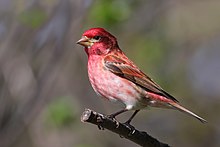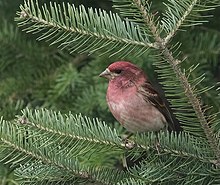Purple finch
| Purple finch Temporal range:
| |
|---|---|

| |
| Male | |

| |
| Female | |
| Scientific classification | |
| Domain: | Eukaryota |
| Kingdom: | Animalia |
| Phylum: | Chordata |
| Class: | Aves |
| Order: | Passeriformes |
| Family: | Fringillidae |
| Subfamily: | Carduelinae |
| Genus: | Haemorhous |
| Species: | H. purpureus
|
| Binomial name | |
| Haemorhous purpureus (Gmelin, 1789)
| |

| |
| Range of C. purpureus Breeding range Year-round range Wintering range
| |
| Synonyms | |
|
Burrica purpurea | |
The purple finch (Haemorhous purpureus) is a bird in the finch
Taxonomy
The purple finch was
Two subspecies are recognised:[5]
- H. p. purpureus (Gmelin, JF, 1789) – central south, southeast Canada and northeast USA
- H. p. californicus (Baird, SF, 1858) – southwest Canada and west USA
This species and the other "American rosefinches" were formerly included with the rosefinches of Eurasia in the genus
Description
The purple finch is 12–16 cm (4.7–6.3 in) in overall length[7] and weighs a mean 23.3 g (0.82 oz), ranging from 19.8–28.4 g (0.7 - 1.0 oz).[8] It has a short forked brown tail and brown wings. Adult males are raspberry red on the head, breast, back and rump; their back is streaked. Adult females have light brown upperparts and white underparts with dark brown streaks throughout; they have a white line on the face above the eye.
The subspecies H. p. californicus differs from the
Distribution and habitat
Their breeding habitat is coniferous and mixed forest in Canada and the northeastern United States, as well as various wooded areas along the U.S. Pacific coast.
Birds from northern Canada migrate to the southern United States; other birds are permanent residents.[citation needed]
The purple finch population has been displaced from some breeding season habitats in the Eastern United States following the introduction of the house finch, which is native to the western U.S. and Mexico. The two species share a similar niche, with the house finch often outcompeting the purple finch during the summer.[11]
Behavior

Food and feeding
These birds forage in trees and bushes, sometimes in ground vegetation. They mainly eat seeds, berries, and insects. They are fond of sunflower seeds, millet, and thistle.
Breeding
The purple finch prefers nesting in lowland coniferous and mixed forests, avoiding more heavily populated urban areas, but sometimes found in rural residential areas. The female Purple Finch usually builds her nest on horizontal branches of coniferous trees, away from the trunk, but occasionally in tree forks. The nest is shaped like an open cup, made up of rootlets, twigs, and weeds, and lined with grass, hair, and moss.
Cultural depictions
The purple finch was designated the state bird of New Hampshire in 1957.[12] The New Hampshire red hen (breed of domestic chicken) was also proposed, but was not chosen in favor of the purple finch.[13] In 1763, Richard Brookes made the description of the female purple finch in Mexico with the name of "chiantototl" (chia seed bird).[14]
References
- . Retrieved 11 November 2021.
- ^ Gmelin, Johann Friedrich (1789). Systema naturae per regna tria naturae : secundum classes, ordines, genera, species, cum characteribus, differentiis, synonymis, locis (in Latin). Vol. 1, Part 2 (13th ed.). Lipsiae [Leipzig]: Georg. Emanuel. Beer. p. 923.
- ^ Paynter, Raymond A. Jr, ed. (1968). Check-List of Birds of the World. Vol. 14. Cambridge, Massachusetts: Museum of Comparative Zoology. p. 270.
- ^ Catesby, Mark (1729–1732). The Natural History of Carolina, Florida and the Bahama Islands (in English and French). Vol. 1. London: W. Innys and R. Manby. p. 41, Plate 41.
- ^ Rasmussen, Pamela, eds. (July 2023). "Finches, euphonias". IOC World Bird List Version 13.2. International Ornithologists' Union. Retrieved 23 August 2023.
- .
- ^ "Purple Finch Identification, All About Birds, Cornell Lab of Ornithology". www.allaboutbirds.org. Retrieved 2024-04-02.
- ISBN 978-1-4200-6444-5.
- ^ Bailey, Florence Merriam; Fuertes, Louis Agassiz (1921). Handbook of Birds of the Western United States. Houghton Mifflin. pp. 310.
- ISBN 0-395-97500-X.
- PMID 28312977.
- ^ "Stage Bird | New Hampshire Almanac | NH.gov". www.nh.gov. Retrieved 2024-04-02.
- ^ "New Hampshire's Avian Emblem: The Purple Finch". www.birdielearning.com. Retrieved 2024-04-15.
- ^ Brookes, Richard (1763). The Natural History of Birds. Vol 2, p 205.
External links
- Interesting Purple Finch Facts at BirdHouses101.com
- "Purple Finch media". Internet Bird Collection.
- Purple Finch photo gallery at VIREO (Drexel University)
- Purple Finch Species Account – Cornell Lab of Ornithology

